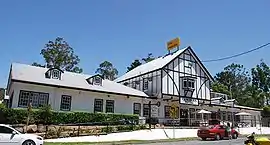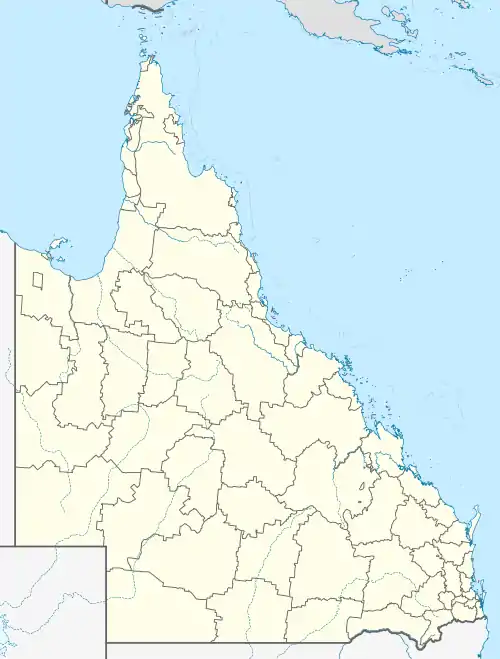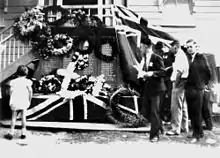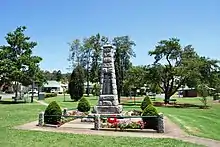Canungra, Queensland
Canungra /kəˈnʌŋɡrə/[2] is a small rural town and locality in the Scenic Rim Region, Queensland, Australia.[3][4] At the 2016 census, Canungra had a population of 1,229.[1]
| Canungra Queensland | |||||||||||||||
|---|---|---|---|---|---|---|---|---|---|---|---|---|---|---|---|
 The historic Canungra Hotel | |||||||||||||||
 Canungra | |||||||||||||||
| Coordinates | 28.0195°S 153.1652°E | ||||||||||||||
| Population | 1,229 (2016 census)[1] | ||||||||||||||
| • Density | 36.25/km2 (93.90/sq mi) | ||||||||||||||
| Postcode(s) | 4275 | ||||||||||||||
| Area | 33.9 km2 (13.1 sq mi) | ||||||||||||||
| Location |
| ||||||||||||||
| LGA(s) | Scenic Rim Region | ||||||||||||||
| State electorate(s) | Scenic Rim | ||||||||||||||
| Federal Division(s) | Wright | ||||||||||||||
| |||||||||||||||
Geography
Located in South East Queensland, Canungra is situated in the Gold Coast hinterland, 32 kilometres (20 mi) west of the Gold Coast and 75 kilometres (47 mi) south of Brisbane.
Nicknamed the "Valley of the Owls", one of the origins of the town's name comes from the Aboriginal word for small owls, "Caningera".[5] The most notable owl found in the area is the Australian boobook owl, which appears in various logos and symbols associated with Canungra. However the word Cunungra comes from the Yugambeh word gungunga meaning "a long flat or clearing".[6]
Residents and businesses in Canungra get their water supply from the Canungra Creek, a tributary of the Albert River. The slopes around Canungra are steep and forested, with some cleared farmlands and rural homes in the flatter valley areas.
History
Canungra Post Office was opened by May 1907 (a receiving office had been open from 1888 under the ownership of Mrs. John Duncan, known at first as Canningera Creek).[7]
Canungra owes its existence to the timber industry and once boasted one of the largest stands of timber in the colony. David Lahey, the father of Romeo Lahey, owned one of Queensland's largest sawmills at Canungra (Lahey's Canungra Sawmill).[8]
From 2 July 1915 until 1 July 1955 the Canungra railway line ran from the Beaudesert line at Logan Village to Canungra railway station (28.0179°S 153.1625°E).[9]
On 1 May 1916 at the Canungra School of Arts auctioneers Isles, Love & Co offered for sale 107 town lots (30 of them with a cottage) in the Cunungra Township Estate in Pine Street, Duncan Street, Appel Street, Kidston Street, Franklin Street, Tamborine Street, Strachan Street and King Street (approx 28.0197°S 153.166161°E) to the immediate south-east of the Canungra railway station.[10][11][12] On the following day 2 May 1916, 30 farm lots were offered. Some of these lots were located to the west of Canungra Creek from the immediate south-west of the town through to the north almost to Benobble railway station. The bulk of the farm lots were to the west of Canungra Creek extending south of the town but bounded to the east by Coomera River.[10][11][12] Many of the blocks were sold.[13]

The Honour Board at the School of Arts Hall was unveiled by the Queensland Governor, Sir Matthew Nathan, on 17 June 1922.[14] The School of Arts burned down on 3 March 1946.[15]

On 25 April 1938, the Canungra War Memorial was unveiled by Member of the Queensland Legislative Assembly for Fassifern, Adolph Gustav Muller.[16]
By the 1940s most of the timber had been cut and sawmills were closing.[17] The historic Laheys Tramway Tunnel is the only remnant of the past sawmilling activities in the area.[18] Following this logging era came beef cattle and dairying.
In 2005, the local Post Office released a special limited-release frank featuring Canungra and the boobook owl.
At the 2016 census, Canungra had a population of 1,229.[1]
Heritage listings
Canungra has a number of heritage-listed sites, including:
- 13-15 Appel Street: Former Canungra Ambulance Station[19]
- 31 Appel Street: Uniting Church[19]
- 1-3 Christie Street: Canungra War Memorial[19]
- Darlington Range Road: Lahey's Canungra Tramway Tunnel[20]
- 10–26 Finch Road: Lahey's Canungra Sawmill[21]
- 15-21 Kidston Street: St Luke's Anglican Church[19]
- 33-41 Kidston Street: Canungra Police Station Reserve[19]
- 51-57 Kidston Street: St Margaret Mary's Catholic Church[19]
- Showground Road: Canungra Sports and Recreation Ground (entry gates)[19]
Military base
The nearby locality of Witheren is the location of a large military establishment called the Kokoda Barracks within the Canungra Military Area, which includes the Land Warfare Centre. It was established during World War II and revived in 1954 to train personnel for the South East Asia Treaty Organization (SEATO) commitment in Malaya and on through to the end of the Vietnam War.[17] The base provides a substantial permanent resident population as well as an ever-changing transient population due to the extensive ongoing training courses on offer at the base.
Cultural references
In Redgum's No. 1 single "I Was Only Nineteen", Canungra is referred to as one of the bases used for training during the Vietnam War. The single was taken from Redgum's 1983 album Caught in the Act.
Facilities
The Scenic Rim Regional Council Library Service operates a branch library at 12 Kidston Street Canungra and provides access to public wifi.[22] Current opening hours and services can be found at the Scenic Rim Regional Council website.[23] Available collections and online resources can be accessed from the online library catalogue.[24]
Economy
The town is home to a small but growing wine industry.[25]
Tourism
Cangungra's economy depends on tourism, being a popular destination for short drives from the Gold Coast and Brisbane. Canungra is nestled in the middle of the four major tourist destinations, and is the gateway to the Gold Coast hinterland; Mount Tamborine, Lamington National Park, O'Reilly's Guesthouse and Binna Burra Lodge. The township is also a meeting place for motor bike club rides, hanggliders, paragliders, birdwatchers and bushwalkers who visit the area annually to take advantage of what the Canungra Valley has to offer. A rodeo is organised each year in July.[25]
Demographics
Canungra has a population of 1229 at the 2016 census. The locality contains 455 households, in which 50.2% of the population are males and 49.8% of the population are females with a median age of 39, 1 year above the national average. The average weekly household income is $1,458, $20 above the national average.
3.3% of Canungra's population is either of Aborigional or Torres Strait Islander descent. 65.0% of the population aged 15 or over is either registered or de facto married, while 35.0% of the population is not married. 30.3% of the population is currently attending some form of a compulsory education. The most common nominated ancestries were Australian (32.5%), English (23.3%) and German (20.2%), while the most common country of birth was Australia (87.9%), and the most commonly spoken language at home was English (88.3%). The most common nominated religions were No religion (33.1%), Catholic (20.2%) and Anglican (17.9%). The most common occupation was a technician/trades worker (18.8%) and the majority/plurality of residents worked 40 or more hours per week (41.3%).[1]
Notable residents
- Des Bartlett, wildlife film maker, born in Canungra[26]
- May Darlington Lahey (1889 - 1984), lawyer and judge, born in Canungra[27]
- Robert Raymond, born in Canungra[28]
See also
References
- Australian Bureau of Statistics (27 June 2017). "Canungra (State Suburb)". 2016 Census QuickStats. Retrieved 8 August 2018.

- Macquarie Dictionary, Fourth Edition (2005). Melbourne, The Macquarie Library Pty Ltd. ISBN 1-876429-14-3
- "Canungra – town in Scenic Rim Region (entry 6109)". Queensland Place Names. Queensland Government. Retrieved 29 June 2017.
- "Canungra – locality in Scenic Rim Region (entry 45124)". Queensland Place Names. Queensland Government. Retrieved 29 June 2017.
- Roberts, Beryl (1991). Stories of the Southside. Archerfield, Queensland: Aussie Books. p. 57. ISBN 0-947336-01-X.
- "South-East Queensland Placenames" (PDF). State Library of Queensland. Archived from the original (PDF) on 29 October 2014. Retrieved 29 October 2014.
- Premier Postal History. "Post Office List". Premier Postal Auctions. Retrieved 10 May 2014.
- Hutton, Drew; Libby Connors (1999). History of the Australian Environment Movement. Cambridge University Press. p. 33. ISBN 052145686X.
- The Canungra Branch Milne, Rod Australian Railway Historical Society Bulletin, January 1993 pp12-19
- "Canungra township (Canungra estate and township)". State Library of Queensland. 1916.
- "THE CANUNGRA ESTATE". The Queenslander. Queensland, Australia. 8 April 1916. p. 10 – via Trove.
- "Advertising". The Telegraph. Queensland, Australia. 1 April 1916. p. 12 (SECOND EDITION). Retrieved 28 May 2020 – via Trove.
- "CANUNGRA ESTATE AND TOWNSHIP". The Brisbane Courier. Queensland, Australia. 5 May 1916. p. 5 – via Trove.
- "THE FORESTRY PROBLEM". The Brisbane Courier. National Library of Australia. 19 June 1922. p. 7.
- "Fire Destroys School of Arts". The Courier-Mail. Brisbane: National Library of Australia. 4 March 1946. p. 3.
- "Canungra War Memorial". Queensland War Memorial Register. Archived from the original on 7 April 2014. Retrieved 3 April 2014.
- Queensland Environmental Protection Agency (2000). Heritage Trails of the Great South East. State of Queensland. p. 16. ISBN 0-7345-1008-X.
- The Canungra and Pine Creek Logging Tramway Burke, David Australia Railway Historical Society Bulletin, May/June 1950,pp8-10/24-25
- "Local Heritage * Finch Road: The Duncan, Christie, Smith Family Cemetery Register" (PDF). Scenic Rim Regional Council. Archived from the original (PDF) on 24 September 2015. Retrieved 9 February 2015.
- "Lahey's Canungra Tramway Tunnel (entry 602529)". Queensland Heritage Register. Queensland Heritage Council. Retrieved 12 July 2013.
- "Lahey's Canungra Sawmill Complex (entry 700002)". Queensland Heritage Register. Queensland Heritage Council. Retrieved 12 July 2013.
- "Queensland Public Library Directory". Public Libraries Connect. 28 April 2014. Archived from the original on 24 January 2018. Retrieved 24 January 2018.
- "Libraries - Scenic Rim Regional Council". Scenic Rim Regional Council. Archived from the original on 24 January 2018. Retrieved 24 January 2018.
- "Scenic Rim Library Homepage". Scenic Rim Regional Council Library Service. Archived from the original on 31 March 2018. Retrieved 24 January 2018.
- "Canungra". Scenic Rim Regional Council. Archived from the original on 10 July 2013. Retrieved 28 June 2013.
- "Close encounters of the natural kind: Des Bartlett, 1937-2009". The Sydney Morning Herald. 16 November 2009. Archived from the original on 20 April 2019.
- The University of Melbourne. "Lahey, May - Biographical entry - Australian Women Lawyers as Active Citizens". www.womenaustralia.info. Archived from the original on 26 May 2018. Retrieved 26 May 2018.
- "Robert Raymond's AustLit profile". AustLit. 5 June 2007. Archived from the original on 9 September 2007. Retrieved 26 June 2007.
External links
| Wikimedia Commons has media related to Canungra, Queensland. |